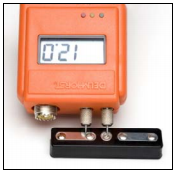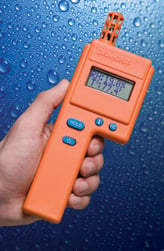As a professional, you know that your tools are a critical part of being able to work efficiently. When you take care of your tools, your tools will take care of you. This is true of all of your tools no matter your profession. From the tillers and harvesting tractors of the farmer, to the hammers, nails, and concrete mixers of a contractor, there are an enormous number of different tools of varying levels of sophistication that professionals use.
Knowing how to take care of one’s tools is an important part of making sure that they remain useful for long. Without proper storage and maintenance, even something as solid as the trusty hammer can become rusted and brittle. The need for proper care is even greater for more modern tools and equipment.
Modern tools such as moisture meters have become an inextricable part of many different industries over the years. For example:
- Flooring contractors and inspectors use these devices to test concrete and adhere to ASTM F-2170 standards
- Farmers use soil meters to monitor available moisture in their soil to optimize irrigation and other meters to test hay and other baled crops for excess moisture.
- Woodworkers test lumber to check acclimation and identify risks for deformation and other potential problems before and/or after turning that lumber into a product.
- Restoration specialists need moisture meters to monitor dry-out efforts, ensure that a building’s moisture levels have been normalized, and pinpoint areas that need more work.
These are just a few examples of the ways that different professionals use moisture meters for their work. For any professional who uses a moisture meter for work, that moisture meter is an investment in the business, one that needs to be taken care of in order to maximize the return on the investment.
While there are a few generally applicable tips for caring for any electronic device, the specific moisture meter you use might have some more specific care instructions.
Caring for a Pin-Type Meter
 With a pin-type meter, keeping your meter working at peak efficiency means taking care of those pins. When you’re using a pin meter, be sure to clean the contact pins of any contaminants after you finish using them. To do this, gently wipe debris off of the pins with a soft, dry cloth. Take care with the tips of the pins, as they will be quite sharp (to make it easier to penetrate a sample of wood).
With a pin-type meter, keeping your meter working at peak efficiency means taking care of those pins. When you’re using a pin meter, be sure to clean the contact pins of any contaminants after you finish using them. To do this, gently wipe debris off of the pins with a soft, dry cloth. Take care with the tips of the pins, as they will be quite sharp (to make it easier to penetrate a sample of wood).
Over time, as pins are used repeatedly, they will become dull or even bent. If this happens, replace the pins right away to make sure that you’re getting the most accurate readings possible. Dull pins don’t penetrate as deeply as easily as sharp pins, and you may not reach the reading depth you wanted to.
Caring for a Pinless Meter
With a pinless meter, you don’t have to worry about wearing out contact pins by repeatedly plunging them into solid objects. However, you do have to take care of the scanning plate that the pinless meter uses to read the electromagnetic radio waves it emits during the scanning process.
When using a pinless meter, avoid dragging the scanning plate along the surface being scanned. Dragging the scanning plate can cause scratches and divots from small irregularities in the surface of the object being scanned. Instead, lift the meter clear of the object being scanned and press it down gently over the next spot you want to scan. Also, when taking a measurement with a pinless meter, make sure that the object being scanned has a flat surface to scan, as uneven or rough surfaces can cause inaccurate readings.
If a pinless meter’s scanning plate gets coated with dust, dirt, water, or some other non-caustic material, gently wipe of the foreign substance with a clean, dry cloth as soon as possible. This will help keep the plate clean so that it can provide the most accurate reading for longer.
Caring for a Thermo-Hygrometer
 Unlike the other types of moisture meters listed previously, a thermo-hygrometer (sometimes called an RH meter) doesn’t measure %MC in a specific object. Instead these meters measure the relative humidity of the area. Restoration experts frequently use these devices to monitor the progress of dry-out efforts.
Unlike the other types of moisture meters listed previously, a thermo-hygrometer (sometimes called an RH meter) doesn’t measure %MC in a specific object. Instead these meters measure the relative humidity of the area. Restoration experts frequently use these devices to monitor the progress of dry-out efforts.
To keep your thermo-hygrometer operating for longer, it’s important to make sure that the sensor element remains free of contamination. The best way to do this is to avoid placing the meter in a caustic or highly contaminated environment. Once the sensor element is contaminated, reading results will begin to suffer from “drift,” and the only way to restore full function at that point is to replace the sensor element (which is something that your meter’s manufacturer can do for you).
Avoid opening up the casing of the meter, as this allows contaminants into it more easily and voids most manufacturer warranties.
General Care Tips
Beyond the specific care tips in the above sections, here are a few things you can do to help keep any moisture meter working for longer:
- Put the meter back in its case when you’re done working with it. This not only protects the meter from contaminants such as dust, pollen, and mold spores in the air, it can keep the meter safe from the shock of impacts. A padded carry case has foam to absorb impacts for the meter, potentially preserving it in the event of a drop from a high shelf.
- Replace the batteries as necessary. When a moisture meter’s batteries are low, it can cause the meter to give inaccurate readings. Sometimes, the only thing you need to return a meter to perfect working orders is a new 9-volt battery (or equivalent).
- Replace optional probes as necessary. Many moisture meters have optional attachments for specific tasks. These optional probes come in a variety of shapes and sizes to help you perform these tasks. Caring for these meters is usually similar to caring for the pins on a pin-type meter, such as wiping off excess dirt when you’re done using the probe. If a probe becomes damaged or irrevocably contaminated, replace it.>
- Store the meter in a cool, dry place. If you’re already keeping your moisture meter in its case, this should be a natural thing to do. Keeping meters in an exceptionally hot or wet environment causes damage to the meter, and can make them lose calibration or totally fail much more quickly than they should.
These are just a few basic care tips for moisture meters to help you get the most useful life out of your investment. To learn more about moisture meters, check out our Moisture Meters 101 Guide at the link below.
Comments